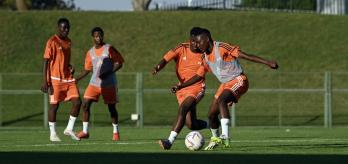Professor Kevin Norton is a leading expert in the evolution of elite sports performance, based at the University of South Australia. In this session, he examines how football is evolving, before going on to consider how coaches can adapt to these changes and what football might look like in the future. The presentation is followed by a Q&A hosted by Dr Paul Bradley of FIFA and featuring Dr Dave Archer of the University of Sunderland, another expert in game evolution.
Highlight evolutionary trends in various football performance metrics and examine the reasons for these changes.
Elite football is becoming more demanding. To cope with these demands, players need high levels of physical fitness and technical proficiency, as well as the ability to make quick decisions. Effective coaching needs to reflect these changes, to ensure players can perform in an elite competitive environment and are physically robust enough to deal with the demands of the game without increasing their risk of injury.
The information from this session can be used to help coaches decide on the best ways to prepare their squads, as well as which performance attributes to prioritise when recruiting players.
Watch presentation
Read summary
Part 1: Evolution and why it matters
All sports are developing, and football is no exception. Most developments in football fall into one of three broad categories. Firstly, there are changes to the physical demands players experience as they exert themselves during matches. Secondly, the range of technical skills players are asked to perform is evolving. Finally, there are also broader changes in patterns of play and stylistic aspects of the game associated with popular coaching models and advances in coaching. Understanding these changes and the mechanisms behind them could allow us to predict how demands on players might change in the future. If we could do that, we could adjust our approach to player recruitment, training and welfare to make sure our teams are fit for the modern game.
Part 2: Changing physical demands
In this section, Professor Norton examines both how and why the increasing physical demands on players are manifesting themselves across multiple world-wide competitions. For instance, he explains that modern-day players are expected to sprint more frequently during matches than their counterparts ten years ago, a development that brings with it higher physical demands on players and increased potential for injuries.
Part 3: Technical and tactical changes
The next section of the presentation demonstrates how the game has become more technical in recent times, and how this has led to an increase in the number and accuracy of passes elite players are expected to make. Professor Norton also considers some wider changes to patterns of play and whether they complement developments in other areas. For instance, although the game still lasts 90 minutes in theory, the total time required to complete a game is getting longer, because there are more breaks in play. On the one hand, these breaks can give players the chance to draw breath during games. On the other, this recovery time may also enable players to perform more intense activity when the game resumes, thus increasing the overall physical demands on players.
Part 4: Implications and the future of football
In his conclusion, Professor Norton considers how we can apply this knowledge of the way football is developing in a practical setting. For example, this knowledge might enable coaches to optimise their training methods to enhance performance and reduce the potential for injuries, as well as to refine their recruitment strategies and build squads tailored to the playing style they wish to adopt. If you understand the generic drivers behind the evolution of football, you can also speculate as to how football might look in the future. For instance, if current trends continue, pace, power, rapid decision-making or the ability to pass the ball precisely at high speed might become even more important. If so, this evolution may have tactical implications, because the higher the tempo, the less time players have to make the right decisions.
Q&A
01:13
Can change go on forever, or will it have to slow down in the future?
05:10
Have some positional roles evolved more than others?
08:13
The game is evolving at team level, but so are individual positions. What is driving these changes?
15:44
Data from the English Premier League and the FIFA Women’s World Cup seemed to show faster rates of change than for any other competition. Why is change so rapid in these competitions?
19:35
What changes do teams need to make to the way they prepare players for the modern game?
24:55
The senior game is evolving rapidly. What are the consequences for players transitioning from youth football into senior football?
29:04
What can be done to reduce the potential for injuries, given that the game is getting faster?
34:56
What specific types of training can coaches use to develop and/or maintain the physical, technical and tactical capabilities of their players?
42:10
What are the most simple and effective practices coaches could implement to prepare for these evolutions?

















